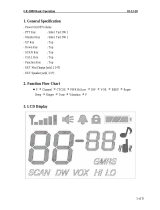
15
Key Tone
This feature allows the transceiver to sound a confirmation tone whenever
the following keys are pressed: Monitor (M) Button, Up/Down Buttons, MODE
Button, SCAN Button, or the EMG Button.
To turn the key tones on or off:
- From GMRS standby mode, press the MODE Button six times until bP,
the Bell (
) icon, and On or oF flash on the LCD display.
- Press the Up or Down Button to toggle the key tone feature On or Off.
- Press the PTT button momentarily to confirm selection.
When the key tone feature is on, the Bell icon appears steady on the
display, and the beep tones sound in response to button activation.
Caller Identification (ID) Select
The caller ID function allows you to assign an ID code between 1 and 10;
this code accompanies your transmission whenever you call another party,
and will appear at the receiving unit, provided it has caller ID capability.
To select a caller ID code for your unit:
- From GMRS standby mode, press the MODE button 7 times; Id ap
pears, together with a flashing ID and number (or oF) indication.
- If oF appears, press the Up or Down Button to select the desired caller
identification code for your unit between 1 and 10.
- Press the PTT button momentarily to confirm selection.
Now, your caller ID number will accompany each transmission, and will
appear on the receiving unit, if so equipped, and vice-versa.
Call Ringer Selection Mode
The transceiver provides 3 user-selectable call ringer melodies to alert
you to an incoming call.
To select your favorite call ringer melody:
- From GMRS standby mode, press the MODE button 8 times;
C will appear on the display, together with a flashing number (or oF)
between 01 and 03, and an appropriate call ring.




















